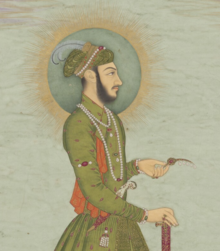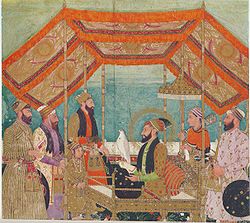Muhammad Azam Shah
| Azam Shah | |||||
|---|---|---|---|---|---|
| Padishah Al-Sultan Al-Azam | |||||
 Azam Shah holding a turban jewelc. 1675 | |||||
| Emperor of Hindustan | |||||
| Reign | 14 March 1707 – 20 June 1707 | ||||
| Predecessor | Aurangzeb | ||||
| Successor | Bahadur Shah I | ||||
| SubahdarofBengal | |||||
| Reign | 1677–1680 | ||||
| Predecessor | Fidai Khan II | ||||
| Successor | Shaista Khan | ||||
| Badshah | Aurangzeb | ||||
| Born | 28 June 1653 Shahi Qila, Burhanpur,Mughal Empire | ||||
| Died | 20 June 1707(aged 53) Agra Subah,Mughal Empire | ||||
| Burial | Khuldabad,Maharashtra,India | ||||
| Consort | |||||
| Wives | |||||
| Issue |
| ||||
| |||||
| House | House of Babur | ||||
| Dynasty | Timurid dynasty | ||||
| Father | Aurangzeb | ||||
| Mother | Dilras Banu Begum | ||||
| Religion | Sunni Islam(Hanafi) | ||||
| Mughal emperors | ||||||||||||||||||||||||||||||||||||||||||||||
|---|---|---|---|---|---|---|---|---|---|---|---|---|---|---|---|---|---|---|---|---|---|---|---|---|---|---|---|---|---|---|---|---|---|---|---|---|---|---|---|---|---|---|---|---|---|---|
|
||||||||||||||||||||||||||||||||||||||||||||||
Mirza Abu'l Fayaz Qutb-ud-Din Mohammad Azam(28 June 1653 – 20 June 1707), commonly known asAzam Shah,was briefly the seventhMughal emperorfrom 14 March to 20 June 1707. He was the third son of the sixth Mughal emperorAurangzeband his chief consortDilras Banu Begum.
Azam was appointed as theheir-apparent(Shahi Ali Jah) to his father on 12 August 1681 and retained that position until Aurangzeb's death.[2]During his long military career, he served as the viceroy ofBerar Subah,Malwa,Bengal,Gujaratand theDeccan.Azam ascended theMughalthrone inAhmednagarupon the death of his father on 14 March 1707. However, he and his three sons,Bidar Bakht,Jawan Bakht and Sikandar Shan, were later defeated and killed by Azam Shah's older half-brother, Shah Alam (later crowned asBahadur Shah I), during theBattle of Jajauon 20 June 1707.
Early life
[edit]Birth
[edit]Qutb-ud-Din Muhammad Azam was born on 28 June 1653 inBurhanpur[3]to Prince Muhi-ud-Din (later known as 'Aurangzeb' upon his accession) and his first wifeDilras Banu Begum.[4][5][6][7]His mother, who died four years after giving birth to him, was the daughter ofMirza Badi-uz-Zaman Safavi(titled Shah Nawaz Khan) and a princess of the prominentSafavid dynastyofPersia.[8]Therefore, Azam was not only a Timurid from his father's side, but also had in him the royal blood of the Safavid dynasty, a fact which Azam was extremely proud of and after the death of his younger brother, PrinceMuhammad Akbar,the only son of Aurangzeb who could boast of being of the purest blood.[9]
Azam's other half-brothers, Shah Alam (laterBahadur Shah I) andMuhammad Kam Bakhshbeing the sons of Hindu wives of Aurangzeb.[10]According toNiccolao Manucci,the courtiers were very impressed by Azam's royal Persian ancestry and the fact that he was the grandson of Shah Nawaz Khan Safavi.[11]
Character
[edit]
As Azam grew up, he was distinguished for his wisdom, excellence, and chivalry.[12][13]Aurangzeb used to be extremely delighted with his son's noble character and excellent manners, and thought of him as his comrade rather than his son. He often used to say, "between this pair of matchless friends, a separation is imminent."[14]Azam's siblings included his older sisters, the princesses:Zeb-un-Nissa,Zinat-un-Nissa,Zubdat-un-Nissaand his younger brother, Prince Muhammad Akbar.
Personal life
[edit]Azam was first married on 13 May 1668 to anAhomprincess,Ramani Gabharu,whose name was changed to Rahmat Bano Begum. She was the daughter of the Ahom king, Swargadeo Jayadhwaj Singh, and the marriage was a political one.[citation needed]
On 3 January 1669, Azam married his cousin, PrincessJahanzeb Bano Begum,the daughter of his eldest uncle Crown PrinceDara Shikohand his beloved wife Nadira Bano Begum.[citation needed]
Jahanzeb was his chief wife and his favorite wife, whom he loved dearly. She gave birth to her eldest son on 4 August 1670. His grandfather Aurangzeb named him 'Bidar Bakht'. Aurangzeb, throughout his life, always loved the three of Azam and Jahanzeb (who is his favorite daughter-in-law) and Prince Bidar Bakht, a brave and successful general. Bidar Bakht was also Aurangzeb's favorite grandson.[citation needed]
Azam's third marriage was fixed with Iran Dukht Rahmat Bano (Pari Bibi), daughter of Aurangzeb's maternal uncleShaista Khan.However, the marriage could not take place due to the sudden death of Pari Bibi inDhakain 1678. In her memory, amazar (mausoleum)was constructed inFort Aurangabad(now Lalbagh Fort) in Dhaka.
As part of a political alliance, Azam later married his third (and last) wife, Shahar Bano Begum (Padshah Bibi), in 1681. She was a princess of the Adil Shahi dynasty and the daughter of the ruler Ali Adil Shah II. Despite Bijapur and his other marriages, Azam's love for Jahanzeb remained unchanged. Because when she died in 1705, he was filled with great sadness and despair which darkened the rest of his life.
Siege of Bijapur
[edit]
In the year 1685 Aurangzeb dispatched his son Muhammad Azam Shah with a force of nearly 50,000 men to captureBijapur Fortand defeatSikandar Adil Shahthe ruler of Bijapur who refused to be a vassal. The Mughals led by Muhammad Azam Shah could not make any advancements upon Bijapur Fort mainly due to the superior usage of cannon batteries on both sides. Outraged by the stalemate Aurangzeb himself arrived on 4 September 1686 and commanded theSiege of Bijapurafter eight days of fighting and the Mughals were victorious.[citation needed]
Subahdar of Bengal
[edit]Prince Azam was appointed the governor (Subahdar) ofBerar Subah,MalwaandBengalfrom 1678 to 1701 upon the death of his predecessor, Azam Khan Koka.[15]He successfully captured theKamrup regionin February 1679. He founded the incompleteLalbagh Fortin Dacca. During his administration, Mir Maula was appointedDiwanand Muluk Chand asHuzur-Navisfor revenue collection.[15]Prince Azam was recalled by Aurangzeb and left Dacca on 6 October 1679.[15]UnderMarathasBengal went under administration of theNawabs of Murshidabad.
He later became the governor ofGujaratfrom 1701 to 1706.
Accession
[edit]In third week of February 1707 in a bid to prevent a war of succession, Aurangzeb separated Azam and his younger half-brother, Kam Baksh, whom Azam particularly loathed. He sent Azam to Malwa and Kam Baksh to Bijapur. A few days before his death he wrote farewell letters to Azam. The next morning, Azam who had tarried outsideAhmednagarinstead of proceeding to Malwa, arrived at the imperial camp and conveyed his father's body for burial at his tomb atDaulatabad.[16]Azam Shah proclaimed himselfEmperorand seized the throne. In the political struggles following the disputed succession, he and his son Prince Bidar Bakht were defeated and killed inBattle of Jajauon 20 June 1707 against elder half-brother,Prince Muhammad Mu'azzam,who succeeded their father to theMughalthrone.[17]Azam Shah was killed by a musket shot which is believed to be fired by Isha Khan Main a jamindar of lakhi jangal of lahore subah. His grave along with that of his wife, lies in thedargahcomplex of Sufi saint,Sheikh Zainuddin,atKhuldabadnearAurangabad,which also houses thetomb of Aurangzebto the west.[18]
Ancestry
[edit]| Ancestors of Muhammad Azam Shah | |||||||||||||||||||||||||||||||||||||||||||||||||||||||||||||||||||||||||||||||||||||||||||||||||||||||||||||||||||||||||||||||||||||||||||||||||||||||||||||||||||||||||||||||||||||||||||||||||||||||||||||||||||||||||||||||||||||||||||||||||||||||||||||||||||||||||
|---|---|---|---|---|---|---|---|---|---|---|---|---|---|---|---|---|---|---|---|---|---|---|---|---|---|---|---|---|---|---|---|---|---|---|---|---|---|---|---|---|---|---|---|---|---|---|---|---|---|---|---|---|---|---|---|---|---|---|---|---|---|---|---|---|---|---|---|---|---|---|---|---|---|---|---|---|---|---|---|---|---|---|---|---|---|---|---|---|---|---|---|---|---|---|---|---|---|---|---|---|---|---|---|---|---|---|---|---|---|---|---|---|---|---|---|---|---|---|---|---|---|---|---|---|---|---|---|---|---|---|---|---|---|---|---|---|---|---|---|---|---|---|---|---|---|---|---|---|---|---|---|---|---|---|---|---|---|---|---|---|---|---|---|---|---|---|---|---|---|---|---|---|---|---|---|---|---|---|---|---|---|---|---|---|---|---|---|---|---|---|---|---|---|---|---|---|---|---|---|---|---|---|---|---|---|---|---|---|---|---|---|---|---|---|---|---|---|---|---|---|---|---|---|---|---|---|---|---|---|---|---|---|---|---|---|---|---|---|---|---|---|---|---|---|---|---|---|---|---|---|---|---|---|---|---|---|---|---|---|---|---|---|---|---|---|
| |||||||||||||||||||||||||||||||||||||||||||||||||||||||||||||||||||||||||||||||||||||||||||||||||||||||||||||||||||||||||||||||||||||||||||||||||||||||||||||||||||||||||||||||||||||||||||||||||||||||||||||||||||||||||||||||||||||||||||||||||||||||||||||||||||||||||
Full title
[edit]Padshah-i-Mumalik Abu'l Faaiz Qutb-ud-Din Muhammad Azam Shah-i-Ali Jah Ghazi
References
[edit]- ^Garg, Sanjay (2018).Studies in Indo-Muslim History by S.H. Hodivala Volume II: A Critical Commentary on Elliot and Dowson's History of India as Told by its Own Historians (Vols. V-VIII) & Yule and Burnell's Hobson-Jobson.Routledge.ISBN9780429757778.
- ^Sir Jadunath Sarkar (1925).Anecdotes of Aurangzib.M.C. Sarkar & Sons. p. 21.
- ^Sarkar, Sir Jadunath (1912).History of Aurangzib Vol. I(PDF).Calcutta: M.C. Sarkar & Sons. p. 71.
- ^Eraly, Abraham (2007).The Mughal World: Life in India's Last Golden Age.Penguin Books India. p. 147.
- ^Chandra, Satish (2002).Parties and politics at the Mughal Court, 1707–1740.Oxford University Press.p. 50.
- ^Koch, Ebba (1997).King of the world: the Padshahnama.Azimuth Ed. p. 104.
- ^Nath, Renuka (1990).Notable Mughal and Hindu women in the 16th and 17th centuries A.D.New Delhi: Inter-India Publ. p. 148.
- ^Annie Krieger-Krynicki (2005).Captive princess: Zebunissa, daughter of Emperor Aurangzeb.Oxford University Press.p. 1.
- ^Sarkar, Sir Jadunath (1916).History of Aurangzib: First half of the reign, 1658–1681.M.C. Sarkar & sons. p. 54.
- ^Sir Jadunath Sarkar (1933).Studies in Aurangzib's reign: (being Studies in Mughal India, first series).Orient Longman. p. 43.
- ^Krynicki, Annie Krieger (2005).Captive Princess: Zebunissa, daughter of Emperor Aurangzeb.Oxford University Press. p. 102.ISBN9780195798371.
- ^Elliot, Henry Miers (1959).The History of India: 1959 Volume 30 of The History of India: As Told by Its Own Historians; the Muhammadan Period; the Posthumous Papers of H. M. Elliot, Sir Henry Miers Elliot.Susil Gupta (India) Private. p. 48.
- ^Sarkar, Sir Jadunath (1974).History of Aurangzib: mainly based on Persian sources, Volume 5.Orient Longman. p. 219.
- ^Saqi Musta'idd Khan, Jadunath Sarkar (1947).Maasir-i-'Alamgiri: A History of the Emperor Aurangzib-'Alamgir.Royal Asiatic Society of Bengal. p. 320.
- ^abcKarim, Abdul (2012)."Muhammad Azam, Prince".InIslam, Sirajul;Jamal, Ahmed A. (eds.).Banglapedia: National Encyclopedia of Bangladesh(Second ed.).Asiatic Society of Bangladesh.
- ^Eraly, Abraham (2000).Emperors of the peacock throne: the saga of the great Mughals([Rev. ed.]. ed.). New Delhi: Penguin books. pp. 510–513.ISBN9780141001432.
- ^"Mughal dynasty".
- ^"World Heritage Sites – Ellora Caves – Khuldabad".Archaeological Survey of India.Archived fromthe originalon 6 May 2015.Retrieved15 April2015.
